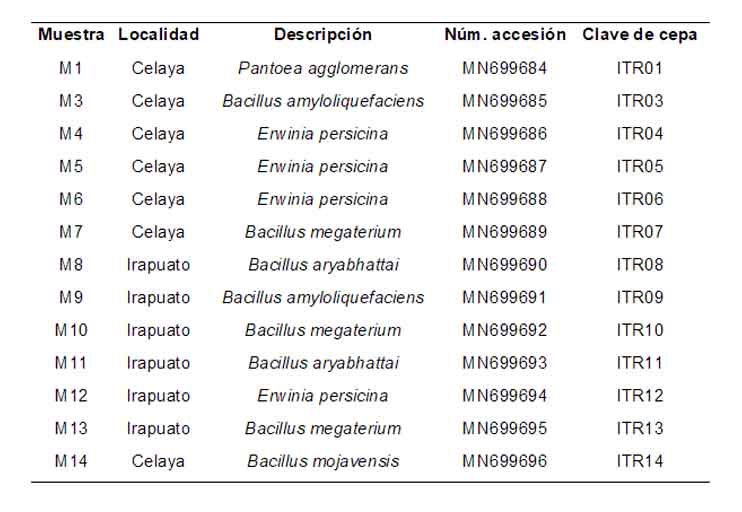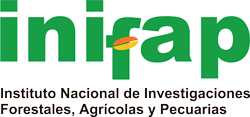Identification of bacteria associated with symptoms in foliage of garlic in two localities of Guanajuato
DOI:
https://doi.org/10.29312/remexca.v16i1.3382Keywords:
Allium sativum L., bacteriosis in garlic, molecular identification, pathogenicityAbstract
Pathogenic bacteria are responsible for major impacts on major crops, causing from moderate damage to total loss. In garlic plants grown during the autumn-winter cycle 2016-2017 in two localities, Celaya and Irapuato (state of Guanajuato, Mexico), symptoms of yellow striae were detected on the leaf margin from two months after sowing. This study aimed to isolate and identify the causal agents associated with these symptoms. From 62 foliage samples with characteristic manifestations of the disease in three garlic materials, 74 pure bacterial isolates were obtained and the 13 most representative were selected according to their colonial morphology and were molecularly identified by amplification and sequencing of the 16S ribosomal gene. The following species were identified for the locality of Celaya: Pantoea agglomerans, Bacillus amyloliquefaciens, Erwinia persicina, Bacillus megaterium and Bacillus mojavensis and for Irapuato: Bacillus aryabhattai, B. amyloliquefaciens, B. megaterium and Erwinia persicina. These bacteria turned out to be of phytosanitary importance in the vegetative development and bulb formation phases, as they were recovered from damaged tissue obtained from previously inoculated plants. To the best of our knowledge, this is the first report of the presence of these bacteria related to the symptoms described in garlic crops and to the deterioration of bulbs during postharvest storage.
Downloads
References
Aketi, R.; Sharma, S. K.; Sharma, M. P.; Namrata, Y. and Joshi, O. P. 2014. Inoculation of zinc solubilizing Bacillus aryabhattai strains for improved growth, mobilization and biofortification of zinc in soybean and wheat cultivated in Vertisols of central India. Applied Soil Ecology. 73(1):87-96. http://doi/10.1016/j.apsoil.2013.08.009.
Akram, W.; Aslamc, H.; Ahmad S. R.; Anjumd , T.; Yasind, N. A.; Khanc, W. U.; Ahmada, A.; Guoa, J.; Wua, T.; Luoa, W. and Li, G. 2019. Bacillus megaterium strain A12 ameliorates salinity stress in tomato plants through multiple mechanisms. Journal of Plant Interactions. 14(1):506-518. https://doi.org/10.1080/17429145.2019.1662497.
Badui-Dergal, S. 2012. Química de los alimentos. Edición Pearson Addison Wesley. Quinta Ed. 744 p. ISBN: 978-607-32-1508-4. https://es.slideshare.net/marcovinicioroblesaguilar/quimica-de-los-alimentos-5a-edicin.
Burba, J. L. 2009. Garlic (Allium sativum L.) genetic improvement and seed production. Possibilities of adaptation to variable environments. Revista Colombiana de Ciencias Hortícolas. 3(1):28-44.
FAO. 2018. Base de datos estadística FAOSTAT. http://www.fao/faostat/es/#data/QC.
Gálvez, L.; Gil-Serna, J.; García-Díaz, M. and Palmero, D. 2015. First report of a garlic bulb rot caused by Erwinia persicina in Europe. Plant Disease. 99(5):723. https://doi.org/10.1094/PDIS-11-14-1195-PDN.
Hawkes, C. V.; Waring, B. G.; Rocca, J. D. and Kivlin, S. N. 2017. Historical climate controls soil respiration responses to current soil moisture. Proceedings of the National Academy of Sciences. 114(24):6322-6327. https://doi:10.1073/pnas.1620811114.
Inafed. 2017a. Características y uso de suelo en Celaya. Gobierno del Estado de Guanajuato. https://www.inafed.gob.mx/work/enciclopedia/EMM11guanajuato/municipios/11007a.html.
Inafed. 2017b. Características y uso de suelo en Irapuato. https://inafed.gob.mx/work/enciclopedia/EMM11guanajuato/municipios/11017a.html.
Jasim, B.; Sreelakshmi, S.; Mathew, J. and Radhakrishnan, E. K. 2016. Identification of endophytic Bacillus mojavensis with highly specialized broad spectrum antibacterial activity. 6(2):187-196. Doi: 10.1007/s13205-016-0508-5.
Jiménez-Díaz, R. M. 2017. Las enfermedades de las plantas: impactos, amenazas y control. Boletín de la Real Academia de Córdoba. BRAC. 166(1):111-130. https://www.researchgate.net/publication/324091733-las-enfermedades-de-las-plantas-impactos-amenazas-y-control.
Khade, Y.; Thangasamy, A. and Gorrepati, K. 2017. Garlic production technology. Indian Horticulture. 62(1):57-59.
Klindworth, A.; Pruesse, E.; Schweer, T.; Peplies, J.; Quast, C.; Horn, M.; Glöckner, F. 2013. Evaluation of general 16S ribosomal RNA gene PCR primers for classical and next-generation sequencing-based diversity studies. Nucleic Acids Res. 7(1):1-41. Doi: 10.1093/nar/gks808.
Li, X.; Zhang, Y.; Wei, Z.; Guan, Z.; Cai, Y. and Liao, X. 2016. Antifungal activity of Isolated Bacillus amyloliquefaciens SYBC H47 for the biocontrol of peach gummosis. PLoS ONE. 11(9):e0162125. https://doi.org/10.1371/journal.pone.0162125.
Marín, F.; Santos, M.; Carretero, F.; Yau, J. A. and Diánez, F. 2011. Erwinia aphidicola isolated from commercial bean seeds (Phaseolus vulgaris). Phytoparasitica. 39(5):483-489. https://doi.org/10.1007/s12600-011-0190-4.
Navarrete-Maya, R.; Aranda-Ocampo, S.; Rodríguez-Mejía, M. L.; Moya-Hernández, S. L y González-Ochoa, M. G. 2014. Bacterias fitopatógenas en semillas: su detección y regulación. Revista Mexicana de Fitopatología. 32(2):75-88. http://rmf.smf.org.mx/Vol3222014/AR/32-2-01.pdf.
Navarro-León, M. J.; Maldonado-Mancera, M. T.; Ramírez-Pimentel, J. G.; Aguirre-Mancilla, C. L.; Pérez-Moreno, L.; Covarrubias-Prieto, J. y Raya-Pérez, J. C. 2019. El recubrimiento de semilla de ajo preserva la viabilidad. Ciencia y Tecnol. Agrop. México. 7(1):1-9. http://somecta.org.mx/Revistas/2019-1/2019-1/Recubrimiento%20de%20semillas%20de%20ajo.pdf.
O’Neill, E. M.; Mucyn, T. S.; Patteson, J. B.; Finkel, O. M.; Chung, E.; Baccile, J. A.; Massolo, E.; Schroeder, F. C.; Dangl, J. L. and Bo, L. 2018. Phevamine A, a small molecule that suppresses plant immune responses. Proceedings of the National Academy of Sciences. 115(41):E9514-E9522. https://doi: 10.1073/pnas.1803779115.
Palacio-Bielsa, A.; Roselló, M. and Llop, P. 2012. Erwinia spp. from pome fruit trees: similarities and differences among pathogenic and non-pathogenic species. 26(1):13-29. https://doi.org/10.1007/s00468-011-0644-9.
Philip, P. 2017. Shining a light on the dark world of plantroot-microbe interactions. PNAS. 114(17):4281-4283. www.pnas.org/cgi/doi/10.1073/pnas.1703800114.
Yang, J.; Yu, J.; Jiang, J.; Liang, C. and Feng, Y. 2017. D-tyrosine affects aggregation behavior of Pantoea agglomerans. Journal Basic Microbiology. 57(2):184-189. https://doi.org/10.1002/jobm.201600455.

Published
How to Cite
Issue
Section
License
Copyright (c) 2025 Revista Mexicana de Ciencias Agrícolas

This work is licensed under a Creative Commons Attribution-NonCommercial 4.0 International License.
The authors who publish in Revista Mexicana de Ciencias Agrícolas accept the following conditions:
In accordance with copyright laws, Revista Mexicana de Ciencias Agrícolas recognizes and respects the authors’ moral right and ownership of property rights which will be transferred to the journal for dissemination in open access. Invariably, all the authors have to sign a letter of transfer of property rights and of originality of the article to Instituto Nacional de Investigaciones Forestales, Agrícolas y Pecuarias (INIFAP) [National Institute of Forestry, Agricultural and Livestock Research]. The author(s) must pay a fee for the reception of articles before proceeding to editorial review.
All the texts published by Revista Mexicana de Ciencias Agrícolas —with no exception— are distributed under a Creative Commons License Attribution-NonCommercial 4.0 International (CC BY-NC 4.0), which allows third parties to use the publication as long as the work’s authorship and its first publication in this journal are mentioned.
The author(s) can enter into independent and additional contractual agreements for the nonexclusive distribution of the version of the article published in Revista Mexicana de Ciencias Agrícolas (for example include it into an institutional repository or publish it in a book) as long as it is clearly and explicitly indicated that the work was published for the first time in Revista Mexicana de Ciencias Agrícolas.
For all the above, the authors shall send the Letter-transfer of Property Rights for the first publication duly filled in and signed by the author(s). This form must be sent as a PDF file to: revista_atm@yahoo.com.mx; cienciasagricola@inifap.gob.mx; remexca2017@gmail.
This work is licensed under a Creative Commons Attribution-Noncommercial 4.0 International license.


